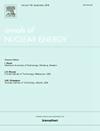Conceptual core design study of a maritime molten salt fast reactor
IF 1.9
3区 工程技术
Q1 NUCLEAR SCIENCE & TECHNOLOGY
引用次数: 0
Abstract
This study compares and analyzes two models of chloride-based fast reactors with a thermal output of 100 MW: Model-1 uses a BeO reflector, while Model-2 uses a PbO reflector. Model-1 utilizes the (n,2n) effect of Be and neutron moderation properties to boost the initial excess reactivity, but it results in lower Pu production rates and a larger reactor size due to the thicker reflector. In contrast, Model-2 has a larger nuclear fuel volume, a high-energy neutron spectrum that leads to higher Pu production, and lower reactivity swings. Stable reactivity control over the course of the 30-year operating cycle is made possible by the application of a control drum replacement approach. Although there were clear variations in power distribution and fuel utilization, both designs showed negative temperature feedback coefficients, ensuring safety during temperature increases. This study aims to contribute to the development of optimal marine reactors by providing insights into the performance and characteristics of these two reactor models.
海上熔盐快堆概念堆芯设计研究
本研究比较分析了两种热输出为100 MW的氯化物基快堆模型:模型1使用BeO反射器,而模型2使用PbO反射器。模型-1利用Be的(n,2n)效应和中子的缓和特性来提高初始过剩反应性,但由于反射器较厚,它导致了较低的Pu生成速率和较大的反应堆尺寸。相比之下,模型-2具有更大的核燃料体积,高能中子谱导致更高的Pu产量,反应性波动更小。在30年的运行周期中,通过采用控制滚筒更换方法,可以实现稳定的反应性控制。尽管在功率分配和燃料利用率方面存在明显差异,但两种设计都显示了负温度反馈系数,从而确保了温度升高时的安全性。本研究旨在通过深入了解这两种反应器模型的性能和特点,为优化船用反应器的开发做出贡献。
本文章由计算机程序翻译,如有差异,请以英文原文为准。
求助全文
约1分钟内获得全文
求助全文
来源期刊

Annals of Nuclear Energy
工程技术-核科学技术
CiteScore
4.30
自引率
21.10%
发文量
632
审稿时长
7.3 months
期刊介绍:
Annals of Nuclear Energy provides an international medium for the communication of original research, ideas and developments in all areas of the field of nuclear energy science and technology. Its scope embraces nuclear fuel reserves, fuel cycles and cost, materials, processing, system and component technology (fission only), design and optimization, direct conversion of nuclear energy sources, environmental control, reactor physics, heat transfer and fluid dynamics, structural analysis, fuel management, future developments, nuclear fuel and safety, nuclear aerosol, neutron physics, computer technology (both software and hardware), risk assessment, radioactive waste disposal and reactor thermal hydraulics. Papers submitted to Annals need to demonstrate a clear link to nuclear power generation/nuclear engineering. Papers which deal with pure nuclear physics, pure health physics, imaging, or attenuation and shielding properties of concretes and various geological materials are not within the scope of the journal. Also, papers that deal with policy or economics are not within the scope of the journal.
 求助内容:
求助内容: 应助结果提醒方式:
应助结果提醒方式:


